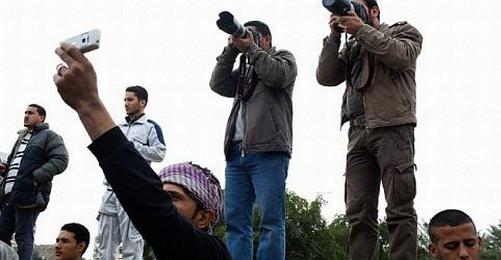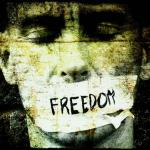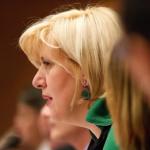Reporters Without Borders (RSF) has this year, for the first time, compiled a list of the world's 10 most dangerous places for the media - the 10 cities, districts, squares, provinces or regions where journalists and netizens were particularly exposed to violence and where freedom of information was flouted. For the second year running, Pakistan was the single deadliest country with a total of 10 journalists killed, most of them murdered.
According to the study of RSF, 66 journalists were killed in 2011.
This is an increase of 16 percent in comparison with the previous year when 57 journalists were killed. The year 2007 takes the lead in the number of killed journalists since the year 2000. A total of 87 journalists were killed in 2007 including war correspondents in Iraq.
RSF listed the following facts and figures:
66 journalists killed (16% more than in 2010)
1,044 journalists arrested
1,959 journalists physically attacked or threatened
499 media censored
71 journalists kidnapped
73 journalists fled their country
5 netizens killed
199 bloggers and netizens arrested
62 bloggers and netizens physically attacked
68 countries subject to Internet censorship
Overall, 2011 took a heavy toll on media freedom. The Arab Spring was at the centre of the news. Of the total of 66 journalists killed in 2011, 20 were killed in the Middle East (twice as many as in 2010). A similar number were killed in Latin America, which is very exposed to the threat of criminal violence. For the second year running, Pakistan was the single deadliest country with a total of 10 journalists killed, most of them murdered. China, Iran and Eritrea continue to be the world's biggest prisons for the media.
The Arab Spring, the protest movements it inspired in nearby countries such as Sudan and Azerbaijan, and the street protests in other countries such as Greece, Belarus, Uganda, Chile and the United States were responsible for the dramatic surge in the number of arrests, from 535 in 2010 to 1,044 in 2011.
The most dangerous places for journalists in 2011 were in Syria, Egypt and Libya, according to the report. From Cairo's Tahrir Square to Khuzdar in southwestern Pakistan, from Mogadishu to the cities of the Philippines, the risks of working as a journalist at times of political instability were highlighted more than ever in 2011.
Read here a brief summary of the alphabetical list of the ten most dangerous places for the media as compiled by RSF:
Manama, Bahrain
The Bahraini authorities did everything possible to prevent international coverage of the pro-democracy demonstrations in the capital, Manama, denying entry to some foreign reporters, and threatening or attacking other foreign reporters or their local contacts. (...). Bahrain is an example of news censorship that succeeded with the complicity of the international community, which said nothing. A newspaper executive and a netizen paid for this censorship with their lives.
Abidjan, Côte d'Ivoire
Abobo, Adjamé, Plateau, Koumassi, Cocody, Yopougon... all of these Abidjan neighbourhoods were dangerous places for the media at one stage or another during the first half of 2011. Journalists were stopped at checkpoints, subjected to heavy-handed interrogation or physically attacked.
Cairo's Tahrir Square, Egypt
The pro-democracy demonstrations that finally forced Hosni Mubarak to stand down as president on 20 February began at the end of January in Tahrir Square. Foreign journalists were systematically attacked during the incredibly violent first week of February, when an all-out hate campaign was waged against the international media from 2 to 5 February.
Misrata, Libya
After liberating Benghazi, the anti-Gaddafi rebels took Misrata. But the regular army staged a counter-offensive and laid siege to the city, cutting it off from the rest of the world and imposing a news and information blockade lasting many weeks, during which its main road, Tripoli Street, was repeatedly the scene of particularly intense fighting. The Battle of Misrata highlighted the risks that reporters take in war zones. Two of the five journalists killed in Libya in 2011 lost their lives in this city.
Veracruz state, Mexico
In 2011 Veracuz became the new epicentre of the federal offensive against the cartels and three journalists were killed there in the course of the year. Around 10 others fled the state as a result of the growing threats to freedom of information and because of the inaction or complicity of the authorities in the face of this threat.
Khuzdar, Pakistan
The many cases of journalists who have been threatened or murdered in Khuzdar district, in the southwestern province of Balochistan, is typical of the extreme violence that prevails in this part of Pakistan. The province's media are caught in the crossfire between the security forces and armed separatists. The murder of Javed Naseer Rind, a former assistant editor of the Daily Tawar newspaper, was the latest example. His body was found on 5 November, nearly three months after he was abducted. An anti-separatist group calling itself the Baloch Musallah Defa Army issued a hit-list at the end of November naming four journalists as earmarked for assassination.
The Manila, Cebu and Cagayan de Oro metropolitan areas on the islands of Luzon and Mindanao, Philippines
Most of the murders and physical attacks on journalists in the Philippines take place in these three metropolitan areas.
Mogadishu, Somalia
Mogadishu is a deadly capital where journalists are exposed to terrible dangers, including being killed by a bomb or a stray bullet or being deliberately targeted by militias hostile to the news media. Three Somali journalists were killed in Mogadishu this year, in August, October and December. And a visiting Malaysian cameraman sustained a fatal gunshot injury to the chest in September while accompanying a Malaysian NGO as it was delivering humanitarian assistance.
Deraa, Homs and Damascus, Syria
Deraa and Homs, the two epicentres of the protests against Bashar al-Assad's regime, have been completely isolated. They and Damascus were especially dangerous for journalists in 2011. The regime has imposed a complete media blackout, refusing to grant visas to foreign reporters and deporting those already in the country. The occasional video footage of the pro-democracy demonstrations that began in March has been filmed by ordinary citizens, who risk their lives to do so. Physical violence is very common. Many bloggers and journalists have fled the country. Around 30 journalists are currently believed to be detained.
Sanaa's Change Square, Yemen
Change Square in Sanaa was the centre of the protests against President Ali Abdallah Saleh and it is there that much of the violence and abuses against journalists took place. Covering the demonstrations and the many bloody clashes with the security forces was dangerous for the media, which were directly targeted by a regime bent on crushing the pro-democracy movement and suppressing coverage of it. Two journalists were killed while covering these demonstrations. Pro-government militiamen known as baltajiyas also carried out punitive raids on the media. Physical violence, destruction of equipment, kidnappings, seizure and destruction of newspapers, and attacks on media offices were all used as part of a policy of systematic violence against media personnel.
Important notes:
The number of detained journalists refers to the number of journalists convicted in 2011. This figure does not include journalists detained pending trial.
The number of killed journalists is related to the number of journalists determined by RSF who were killed entirely on the grounds of their journalistic activities. Unconfirmed incidents or cases where journalists were killed out of reasons not fully related to journalism are not included. (IC/VK)
Source: Reporters Without Borders
Click here to read the full report.






